Neuroengineering IGERT Students Experience Interdisciplinary Research
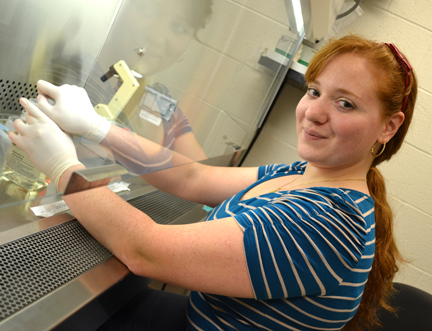
Neuroengineering IGERT graduate student Olivia Cangellaris
One student wants to discover how the brain enables complex thought, such as philosophy. Another wants a field rewarding enough to get him out of bed and to work every morning. Another student, who heard about the IGERT program while jogging, finds the psychology-engineering intersection intriguing and the engineering tools crucial to his work. Still another saw the IGERT as an opportunity to acquire resources, knowledge, and connections in the field of engineering that she wouldn't have had otherwise. No matter why students chose the Neuroengineering IGERT at Illinois, they find interdisciplinary research at the intersection of neuroscience and engineering to be challenging, yet exciting.
Funded by a National Science Foundation Integrative Graduate Education and Research Traineeship (IGERT) grant, the five-year Ph.D. program, "Neuroengineering: A Unified Educational Program for Systems Engineering in Neuroscience," is starting its fourth year and currently has 45 graduate students enrolled. Coming from a range of disciplines (i.e., neuroscience, psychology, molecular and cellular biology, electrical and computer engineering, bioengineering, and the medical scholars program) the students are interested in neuroengineering for reasons that are just as diverse.
For example, Olivia Cangellaris, whose undergraduate degree is in bioengineering, is pursuing both a Ph.D. in Bioengineering and an M.D. in the Medical Scholars Program. Cangellaris has been interested in the brain, particularly "what it is that makes our brains work," ever since middle school. She recalls that reading Jostein Gaardner's The Solitare Mystery, with its subtle philosophical theme, piqued her interest in philosophy. How did she get from Plato and Socrates to brain surgery? "I was just interested in the brain and the fact that a philosopher is able to ask the kinds of questions they ask and question things that are not physically apparent—ask these very abstract questions. I guess I've just always been fascinated with how complex our brains are and how that enables us to be who we are, and do what we do, and think what we think."
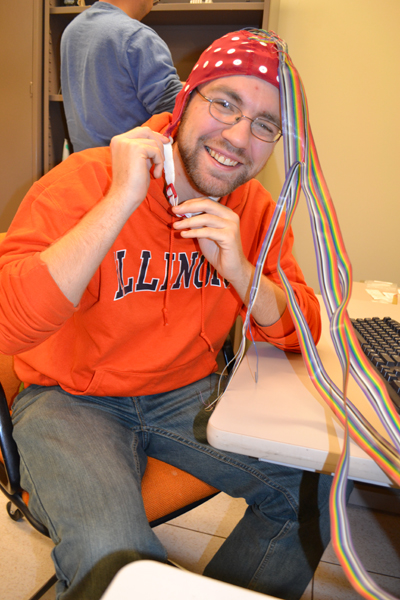
Erik Johnson, IGERT fellow from Electrical Engineering, acts as a guinea pig to have his brain waves analyzed.
It was the IGERT's interface of neuroscience and engineering that intrigued Erik Johnson, an Electrical and Computer Engineering Ph.D. student. In his fourth year in the IGERT, Johnson is specializing in bioimaging: imaging technologies and techniques for neuroscientists.
"As an engineer, I'm very interested in signal processing, data analysis, and the mathematics behind it. But without a driving application, I didn't really see the purpose of doing the mathematics for mathematics' sake. That's not the kind of thing that would get me out of bed in the morning and get me excited about going to work. There are just so many potential applications in this emerging field of neuroengineering, and exciting that you also get to define some of them yourself. So that, to me, has been a big draw and was actually the reason that I joined the IGERT specifically—to be able to pursue those sorts of applications. I think this is a really exciting place where engineers can be motivated by new problems and forced to find solutions that actually have practical value to neuroscientists."
Almost as diverse as their reasons for studying neuroengineering are some of their career goals. For example, Cangellaris wants to practice brain surgery. However, because she's also interested in how technology is influencing medicine, she wants to use technology to treat or manage diseases. "I do think that the way that the medical field is evolving, the way biotechnology is advancing, all of that is shaping how medicine is being performed." She would ultimately like to meld a clinical approach with a technical background, eventually working at a hospital partnered with a research institution in a climate that fosters "dialogue between clinicians and researchers in terms of how you go about approaching the problem and how you go about trying to fix it."
Johnson's career goals? Do neuroengineering research in a national lab or teach neuroengineering in academia.
So far, while the students are finding the interdisciplinary collaboration and communication with people in disciplines other than their own to be challenging, they also find it to be fulfilling in that it causes them to grow as researchers.
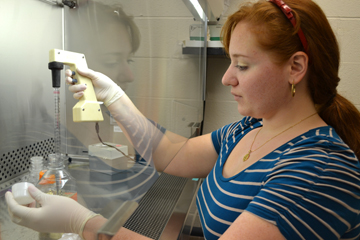
Olivia Cangellaris at work in Martha Gillette's lab in Morrill Hall.
According to Cangellaris, her favorite part of the program is rubbing shoulders with people from different disciplines. "It's really great to have that natural integration of different fields because it forces you to think differently. I think that's what makes a better researcher; it's somebody who can ask questions that they're not comfortable with and take that all into consideration as they're designing their experimental platform, then that continuous dialogue helps shape you into a better researcher.
Has she learned a lot so far from the interdisciplinary collaboration? "It's filled in some holes, but in the lab meetings, the questions that people ask me after I present, I think it's more so informed me of what I don't know. Because people ask me questions, and I say, 'Oh, I didn't think about that.' Because I'm not at that point where I move between thinking like a neuroscientist and an engineer; I think I'm still approaching things from an engineering standpoint. The questions that I'm asking do not include questions that are obvious to a cell biologist. So working in this lab has been great because it's really helping me figure out and identify what I know and what I don't know—what I still have to learn."
Part of the brain-machine interfacing track, Cangellaris is looking forward to the interdisciplinary project this spring. "It's this establishment of a dialogue and learning how to talk to somebody who doesn't necessarily have the same background as you and to convey ideas and to ultimately come up with something new."
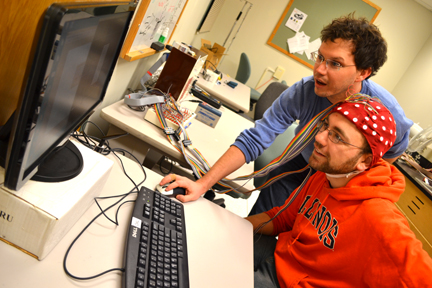
Clockwise: Neuroengineering IGERT students Jamie Norton and Erik Johnson look at data from a brain cap that measures a person's brain activity.
Engineer Erik Johnson admits that communicating with people in other disciplines can sometimes be a challenge.
"Engineers, we are fairly well known for our ability to talk in jargon, especially mathematics. So often when we're talking a potential project up to someone, we have to be very careful about the words we choose, motivate everything well with intuitive examples. On the other hand, the neuroscientists are very well known for all the jargon that they use. I still struggle to keep up with them when they start rattling off brain structures. I know some of them…I'm way ahead of, say, the other students in my lab who have not taken any neuroscience courses and have not been through the IGERT program. It's certainly helped a lot with the communication issue. It doesn't just go away magically. It's something that we're aware of and work at."
Johnson's take on the program? "I think it's really fun. It's really exciting. It's cool to actually be able to tell my friends that I'm a neuroengineer. There are really only a handful of programs in the country trying to do this kind of work…The field as a whole is exciting and emerging. The field is maturing as a whole, so it's really exciting to see. I think a lot of really cool stuff is going to come out of it."
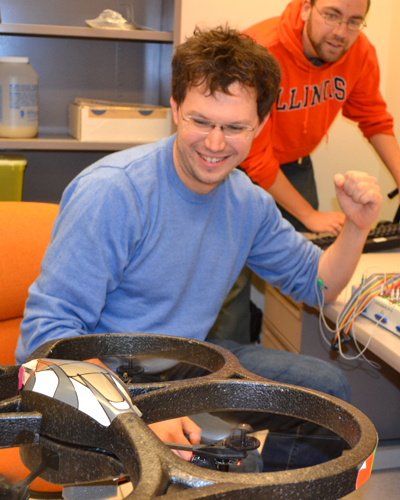
Neuroengineering IGERT fellow Jamie Norton, whose research is brain-machine interfaces
Two other grad students, Jamie Norton and Danielle Dickson, entered the Neuroengineering IGERT from the psychology side.
Norton, who is in his third year in the Ph.D. program, ended up at Illinois through a very circuitous route. While working in Boston after getting his Bachelor's in psychology in Florida, he was running over the noon hour with a jogging buddy/mentor who, having read about NSF's IGERT program, encouraged him to apply. He did some research, found the IGERT at Illinois to be the most interesting and the best fit, and applied.
Danielle Dickson, who majored in cognitive science and linguistics as an undergrad, is in the Psychology Department's cognitive neuroscience division. While she chose the imaging track, she is also interested in brain-machine interfaces because they utilize her primary research method of EEG (Electroencephalography) to record electrical activity of the brain. In one project, she also uses fMRI (Functional Magnetic Resonance Imaging), which measures brain activity via images of blood oxygenation levels in the brain.
Has the Neuroengineering IGERT given these students from non-engineering backgrounds a handle on engineering?
Dickson reports increased understanding of engineering jargon: "I feel a lot more empowered to actually read the methods sections of these papers and be more critical, 'Why did they choose to do it this way? This is unusual,' whereas before, I would have just been like, 'Yea, yea, whatever. They used a 90-degree flip angle and a this-by-this voxel whatever, whatever.'"
While Norton's understanding of engineering has increased, the networking and relationships the program has fostered with engineers are key to his work: "It also empowers you to know who to talk to when there are problems. So it's not just your own knowledge, but knowing where you should look for expert knowledge. In my case, it's really enabled me to talk more with the signal processing guys, really understand the theories that they're applying to their research. Then we're able to collaborate better, and I can tell them what I'm actually trying to accomplish, and then they can think about what methods within their toolbox really apply. You really are empowered just to say, 'I have this specific question I'm trying to answer; I know that this person exists in this other lab, that I've never worked with, but works in this area,' and you can just go talk to them and have a conversation."
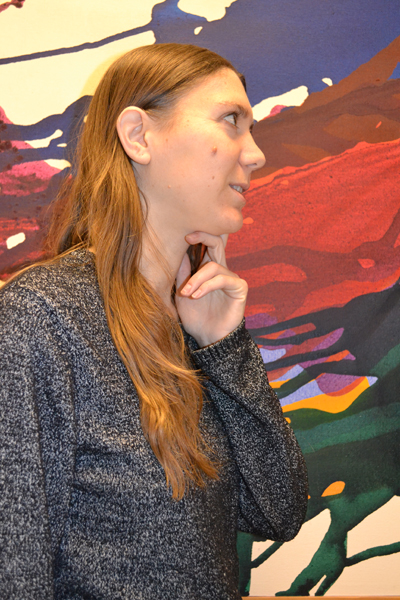
Danielle Dickson, a Neuroengineering IGERT fellow from Psychology's Cognitive Neuroscience division.
Having been exposed to engineering courses through the program, do they now consider themselves to be neuroengineers? "I think it's a side project kind of work for me," answers Dickson, "where I have power to use other techniques and ask questions that I never would have been able to ask before or know how to ask. Until you're exposed to all of these individuals here in the program, you don't even really know, necessarily, that there are people out there whose whole life it is just doing x, y, and z. There are such different problems that they are solving that you wouldn't even know to ask. Now I can better communicate with others and use their input in ways that I wouldn't have thought to use."
But she does consider the engineering knowledge to be beneficial to her work. In a scenario where she is buying new equipment for a lab, she envisions drawing upon her newly-gained knowledge. "You want to know, 'What settings should I use? What kind of materials? Why would you use this amplifier instead of this amplifier? And when you actually open the book, previously it would have been a bunch of jibberish, and now I actually understand, 'Oh, that's why you would want to buy this amplifier instead of this amplifier.' So I can see that it's never going to totally disappear from your life, because it's really valuable information, but it's not necessarily going to guide my work in the way that it guides some other students."
On the other hand, Norton believes engineering is crucial to his work in brain-computer interfaces. "You can't build a brain-computer interface without psychology, neuroscience, and engineering. It's just not possible. You can look at one side, and a lot of researchers do. But I don't think you're going to get anywhere in the long run if you don't consider all angles of the problem. That includes, what are the underlying brain processes? Hardware engineers: we work a lot with the material sciences group on campus…One of my favorite collaborators in my lab is a circuits guy named Dennis. He may be able to improve the equipment that I'm using. So without understanding what they're doing, you don't understand how it fits into the system."
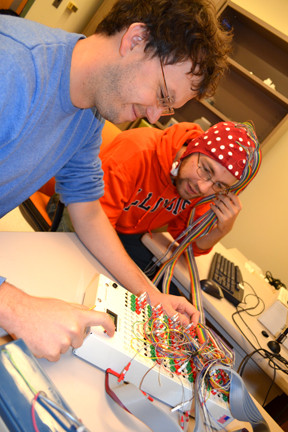
Left to right: Jamie Norton and Erik Johnson measure brain waves in a Beckman lab.
Norton goes on to describe a recent successful collaboration in signal processing. While classifying bad signals, he needed a method which allowed him to get as much information out of the signal as possible. He approached Erik Johnson, who responded, "Yea, we could do this." They've already implemented it, and it improves the signal quality. "So, yea," acknowledges Norton, "if I want to stay in brain-computer interfaces, it's absolutely crucial that I stay in neuroengineering."
Norton considers himself a neuroengineer. According to Dickson, "He's the most neuroengineering person that you're probably going to [find]. Everyone else kind of moves more toward, 'Well, I like the brain, but I'm going to be an engineer, and the brain is cool,' and then I'm more of a, 'Well, the engineering tools are critical to get my research done, but I'm not myself super motivated to tweak the existing tools that have worked for 30 years,' but Jamie is. He has to."
Regarding the somewhat nebulous definition of what a neuroengineer is, the students have evidently devised a kind of continuum. "We talk about it being on a spectrum. It's not a 0 or a 1; it's between 0 and 1. If you say "1" was engineering…" Then they went on to assign various members of their cohort. Most were assigned "slightly in the middle." Says Dickson, "There are people who aren't on the spectrum at all. I think cognitive psychologists aren't really on the spectrum at all." Despite her not considering herself to be a neuroengineer, she does consider herself to be on the spectrum. ("It's like a disorder," quips Norton, in an aside.) Dickson ranks Norton as very central; she considers herself to be closer to the Neuroscience side. "It's a good way of thinking about it that accurately captures the diversity of the group,"she concludes.
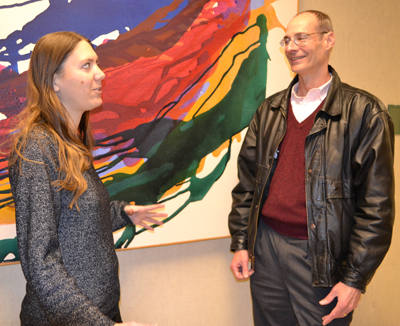
Danielle Dickson and Doug Johnson discuss her research during a chance encounter at Beckman Institute.
If they had to go back, would they choose to do the Neuroengineering IGERT again? "I can't imagine not having that foundation on which to go forward," admits Dickson. "There's so much information that I learned that I didn't know that I needed or could have used, but having it now is invaluable…I can imagine not having it, and that outcome isn't as good as this outcome. I would still be recording brain activity, and I would never know that this world existed!"
Norton agrees. "I did all psych through undergrad, and without the engineering background, especially the signal processing that we learned with Doug, a lot of the stuff just isn't possible. I can't imagine not having the background. Instead of being a curiosity, it now guides my research, as opposed to before, it was an area you avoid because you don't understand."
For more on this topic: IGERT Trains Students at the Intersection of Neuroscience and Engineering looks this cutting-edge program and its goals.
Story and photographs by Elizabeth Innes, Communications Specialist, I-STEM Education Initiative
More: Biology, Engineering, Funded, Graduate Education Reform, IGERT
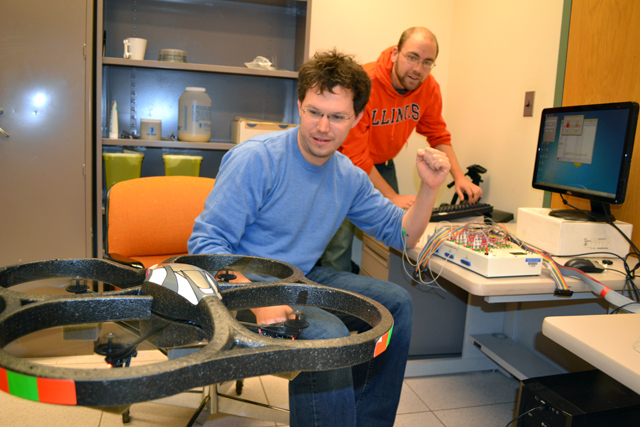
Left to right: Jamie Norton and Erik Johnson demonstrate how electromyography, the electrical activity generated by muscle contraction, can be harnessed, for example, to fly a helecopter.













.jpg)
















